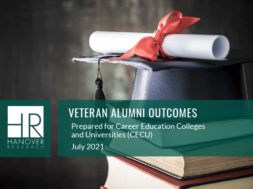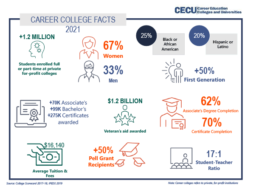
Go Green: The Next Big Thing for Career Education
Written from an interview with Julia Feder, Director, Education, U.S. Green Building Council
How can career educators prepare their students for the year 2020? What skills will students need to get jobs? What new subjects can career education colleges and universities offer to increase student enrollment, retention, and graduation rates?
“Green jobs” are an answer, according to Julia Feder, Director of Education for the U.S. Green Building Council (USGBC). According to the United Nations Environment Program green jobs address, “work in agricultural, manufacturing, research and development, administrative, and service activities that contribute(s) substantially to preserving or restoring environmental quality.” However, Feder likes to take a slightly broader take on green jobs as employment opportunities that build a strong economy, while contributing to a healthy, safe environment and society.
Feder discussed the advantages of a green jobs focused education in a presentation given at the Innovation Education Summit, held the ninth through the 12th of February, in Jackson, Wyoming. The summit, sponsored by Gragg Advertising, a brand development company in Kansas City, Missouri, was held as an opportunity for business and career education executives to meet and exchange ideas.
Feder has a lifetime career as an educator, noting that her educational training experience has addressed curriculum from kindergarten through the college level, and professional education efforts, as well. She is keenly aware of the educational communities concerns, especially with the part that student satisfaction plays in long-term enrollment and retention rates. “I think we all can agree on a common goal of productive and prosperous graduates that find great job opportunities and then stay engaged in and grow with those jobs over time,” she said.
In a litany of compelling data about employability, Feder, who is well-versed in current statistics relating to the educational industry, noted studies showing that only 40 percent of young professionals currently “feel engaged” in their current occupations. Yet, she continued, citing a 2012 Net Impact study, employee satisfaction doubles when workers feel they can make a direct social and environmental impact through their job. Reinforcing that research,
a MonsterTRAK 2013 study found that some 80 percent of young professionals say they are looking for a green job.
Happily, green jobs do exist. The U. S. Bureau of Labor Statistics has found that growth in “green jobs” is four times the combined rate of growth for all other categories.
The jobs exist, young professionals want them, and business needs them. The missing ingredient, according to Feder, is input from the career education industry. Feder believes that a green job-oriented curriculum can help students find careers in green jobs and enjoy lasting professional fulfillment.
The components of a green-job curriculum
What would it look like for green job readiness to be a focal point for your curriculum? Would career educational institutions need large investments to get up to speed? What real career categories might it affect?
The answers to these questions are not always obvious since terms such as “green” and “sustainability” mean different things to different people. More to the point, this field is growing exponentially and at a pace that is often hard to keep up with. It already encompasses jobs that did not exist 10 years ago. Eric Spiegel, President and CEO of Siemens, U.S.A., a member of USGBC, noted,
“60 percent of the jobs in America today did not exist 25 years ago” and “80 percent of the jobs of the future do not exist today.”
For USGBC, the term green is most meaningful in the context of place – the places we live, work, learn, and play. USGBC works to transform the way these places are designed, built, and operated. Of these categories, sustainability operating practices is a particularly hot area, with predictions of phenomenal growth. Feder noted that a number of industries not directly related to construction and building are embracing sustainability operating practices, including such fields as healthcare and hospitality.
Moreover, green career opportunities have evolved. Green building initially focused on the architecture, construction, and engineering fields. However, now that “green building” has grown to be a $1 trillion industry, Feder notes a burgeoning market for credentialed professionals within broader fields including hospitality, healthcare and real estate. These new job titles are as diverse as building facilities managers, sales representatives, customer service representatives, operations managers, and even software developers.
“We have seen a great expansion of sustainability training programs in design, construction, facilities management, real estate, architecture, and engineering, the typical fields that would require it as part of their overall curriculum,” she continues.
“Surprisingly, however, the most remarkable growth in sustainability education, and a huge growth opportunity for green jobs, has occurred in fields, such as business education, hospitality, and healthcare. The reasons are economic: the business management and hospitality industries often require a significant investment in construction, and the interplay between their business goals and the operation of their real estate and building portfolios can be substantial.”
“In the hospitality industry, we are seeing sustainability programs grow into degree programs,” Feder said. “There is a lot of opportunity for career education in that field and others such as customer service. As both large and small corporations commit to sustainability and integrate it into their business models, everyone who interacts with customers will need to be literate in these concepts and able to communicate them to their customers.”
As more companies focus not just on new construction, but the operations and maintenance of their buildings, facilities managers need appropriate training. “Over the next decade, a significant percentage of facility managers will retire. Schools are not producing enough graduates to replace them. That means that in the next decade, we shall see almost 100 percent job placement. Remember, all those facility managers will have to be literate in green and sustainability concepts.”
Across industries, earning a LEED professional credential — these are issued by the Green Business Certification Inc., the certifying body for USGBC — make students “the most sought after professionals in the green building industry,” according to 2014 Burning Glass data.
USGBC’s LEED, or Leadership in Energy and Environmental Design, is a green building certification program that “recognizes best-in-class building strategies and practices.” LEED certification spans new construction projects to operation and maintenance of existing buildings and the establishment of new neighborhood development efforts.
The most useful credential for emerging and transitioning professionals may be the LEED Green Associate, which proves the student’s mastery of sustainability concepts and practices.
“How buildings are operated and maintained — the green, sustainability concepts encompassed by the LEED certification programs — that is where you will see tremendous and diverse opportunities for future professionals,” according to Feder.
The intersection of science, technology, engineering, and math, or STEM, as it is called, will also play a major role in the future job market. Feder cited a U.S. Department of Commerce study predicting employment in those fields will double overall other sectors. Within STEM, green jobs will grow four times as fast as all other sectors combined.
Here again, the most likely green job titles requiring sustainability literacy are predictable: engineers, architects, and construction managers. To take construction as an example, Feder found that green employment is projected to increase at 2.6 percent a year from 2012 to 2022.
While Feder is certain of an emerging trend of green jobs in other career paths such as sales representatives, managers, customer service representatives, operations managers, and software developers, there are currently no specific projections of how many or even the precise titles that will evolve for green-certified opportunities.
Feder and Eric Spiegel of Siemens, U.S.A. tout the power of “teaching while doing.” Returning to the statistic that only about 40 percent of graduates feel engaged in their work, researchers have found that when students have had experiential training in school that statistic reverses and “almost 80 percent feel engaged.”
What career educators can do: start small
Some schools have already invested millions of dollars to create state-of-the-art training facilities for renewable energy and these schools are graduating professionals for this burgeoning field.
Other schools can jump on the green job bandwagon as well, including smaller career education schools. Julia Feder suggests beginning simply: “By identifying one or two classes within existing programs where it makes sense and then fold sustainability concepts into the curriculum. The rest will follow naturally and USGBC, as a nonprofit, is there to help.”
Feder notes that resources are widely and easily available, even for cash-strapped schools. “There are great textbooks and online resources out there to support your efforts, many of which originated with USGBC,” she said. “We designed our resources to be integrated into existing programs.”
Feder offers a suggestion that comes from her own experience: “The LEED Green Associate is the foundational professional credential associated with green building and sustainability. I think that it is appropriate for a broad range of young professionals. I am a LEED Green Associate, yet I do not work directly on green building projects.
“The credential demonstrates my competence and demonstrates that I am literate in these concepts and skills. It is the credential for those who are just entering or soon to be working in this field. Educators can help their students enter these new job areas by integrating preparation for the professional credentials into their curricula as a great first step. If students want to make a larger commitment, they can then consider course work and degree programs that weave sustainability concepts throughout their work.”
How schools benefit by offering sustainability training
A great benefit of green and sustainability training for career educators is recruitment, Feder says. She points out that young and transitioning professionals are “tuned into” green issues. “When a school showcases sustainability as part of its degree programs, its coursework, and its overall institutional practices that demonstrated commitment is very attractive to the students that they want to recruit.”
She points to hard evidence that back up a school’s commitment to sustainability training: green job placement statistics. “These are the jobs in demand today and that demand will only increase,” she says.
“Green coursework and degree programs make students highly competitive. They will be ready to take on the job opportunities that are already in existence and that will be even more abundant — and as yet unknown — as we move forward.”
Career schools can step up to the plate once again
Following the Great Recession of 2008, which decimated the American workforce, the career education industry retrained millions of students, providing them with new skills and even new career paths. Students marched off, diplomas in hand, to careers in diverse fields, from real estate and medical recordkeeping to hospitality, graphics, and landscape design.
The success of career colleges and universities in helping Americans rebound from the Recession is an amazing story. Now there is a new challenge: How do we prepare students for future jobs when we cannot precisely describe those jobs? Much like the nascent computer field in the 1980s, future green jobs will create whole new categories of work, perhaps even new industries.
The future for career educators is not merely teaching given disciplines, or coming up with trendy new subjects. It lies in recognizing where global commerce is going and revitalizing their educational offerings to speak to what students and businesses want now and will want, even before they know it. After all, like fine wine and good whiskey, it takes time and foresight to cultivate good programs.

Julia Feder serves as the Director, Education at USGBC, overseeing a broad range of activities related to the development and delivery of education programs and resources in support of USGBC’s mission to transform the way buildings and communities are designed, built and operated. In this role, Julia has worked to significantly expand USGBC’s utilization of online platforms for bringing education resources to emerging and established green building professionals throughout the world. Though her work at USGBC and as a LEED Green Associate, Ms. Feder works to make the where we live, work, and play healthier and safer places to call home.
Contact Information: Julia Feder // Director, Education // U.S. Green Building Council // 202.552.1356 // jfeder@usgbc.org










